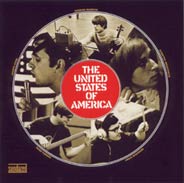The United States Of America
The United States Of America
(Sundazed)
It was really a nice surprise to know about the re-release of this
"classic album" (granted, it's not that well-known), originally
released by Columbia Records in 1968 and which had already been re-released
by UK's Edsel Records in 1987, at the dawn of the digital age. Extremely
beautiful on an aesthetical level, The United States Of America is a
one-of-a-kind type of album for (at least) two reasons: first, it's
the only recorded work by this line-up; then, 'cause it's an original
mixture of pretty different styles, which are given their organization
by a sure hand and an impeccable logic. A work where electric violin,
ragtime piano, female lead vocals, intricate bass parts, marching bands
and an experimental use of electronics brilliantly coexist. A work which
had no "sequels", nor heirs - even Joseph Byrd, the group's
resident genius, could not succeed in continuing the story; and trying
to see the group's heirs in some names that can be said to be superficially
similar in some (minor) aspects of their work it's an absolutely useless
task, obviously; just the way it is for so many innovative groups that
are really unique.
The
nice sound of this re-release - round and clear at the same time - makes
it possible for us to investigate the work's underlying logic, whose
clarity owes a big debt to both The Beatles and the long tradition of
classical music. Add to this an expressive urgency that's typical of
those times - The 60s, with their youth revolt, the Vietnam War, the
experimenting with drugs, musical innovation and so on (the nice and
comprehensive liner notes exclusive to this edition make it possible
for the listener to get a clear mental picture of that era, beyond the
history of the group).
The
first track, The American Metaphysical Circus, is a perfectly representative
microcosmos of the whole album: the calliope melody, the piano, the
orchestra sounding so "Old America", the synthesizer, the
female vocals filtered though a ring modulator, the dry rhythm section,
the sinister atmosphere that becomes a nightmare. Then the record offers,
among other things - sporting an eclecticism that was without a doubt
a big obstacle for many listeners - some vocals somewhat reminiscent
of Grace Slick/Jefferson Airplane, meditative moments, ironic atmospheres
that one could link to Frank Zappa, some episodes à la Beatles,
sonic collages and songs that can only be said to be simply marvelous
- check Love Song For The Dead Ché, which in some ways is the
peak of the album.
What
could I say to those who already own this album in one of its previous
incarnations? I've already mentioned the liner notes, so I'll say of
the new pictures and - again - of the very good sound. BUT: There are
no lyrics (they had been featured in the first release and in the Edsel
1987 edition): WHY? There are a few unreleased tracks, and though they
cannot better the original album - how could they? - they can enrich
our perception of it. Extremely welcome are demos of three songs that
later went on the record; one alternate take, and a couple of unreleased
tracks (the very good Osamu's Birthday and a quite different version
of You Can Never Come Down, which will later be featured on Byrd's solo
album). There are also three unreleased tracks by a line-up headed by
Dorothy Moskowitz, which show us the singer's preferred style; these
songs are pleasant enough - especially the Beatles-influenced Perry
Pier - but they are quite distant from those artistic ambitions which
make it still possible for us to love the group so dearly.
Beppe Colli
© Beppe Colli 2004
CloudsandClocks.net | Aug. 19, 2004











